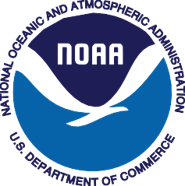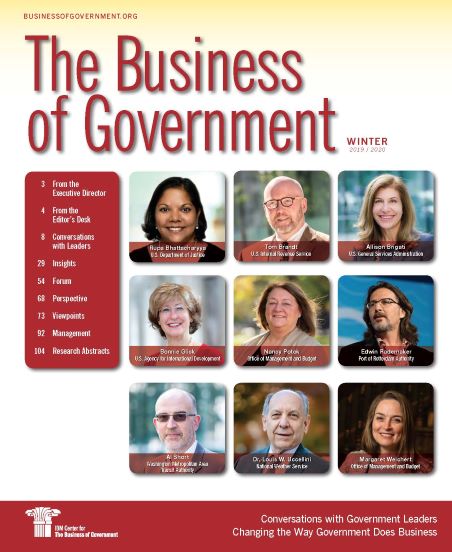
Building a Weather-Ready Nation

Americans are increasingly dependent on timely, reliable, and accurate information on weather, water, and climate for the protection of life and property, as well as the enhancement of the nation’s economy. In fact, a nationwide survey indicates that weather forecasts generate $35 billion in economic benefits to U.S. households, about six times the cost spent on weather forecasting and research. Extreme weather becomes more common and damaging due to a confluence of physical and socioeconomic factors.
Dr. Louis W. Uccellini, director of the National Weather Service (NWS), joined me on The Business of Government Hour to discuss the mission of the National Weather Service, his strategic priorities, and his vision for building a weather- ready nation. The following is an edited excerpt of our discussion.
On the History and Mission of the National Weather Service
In 1970, President Nixon established the National Oceanic and Atmospheric Administration and renamed the Weather Bureau to the National Weather Service. As we approach NOAA’s 50th anniversary and the National Weather Service’s 150th in 2020, we recognize that our past provides the context for who we are today and the inspiration for our future. We’ve come to understand that to fully achieve this mission, we need to connect our forecasts and warnings to the decisions our partners are making in the field. It’s not about just issuing forecasts and warnings, but making sure that decision makers understand and interpret the information to make good decisions. We call this new focus Impact- based Decision Support Services (IDSS). The IDSS offers more effective communication, more tailored customer service, and is more attentive to the “customer experience” as described in the President’s Management Agenda (PMA). We’re facing new challenges, increasing vulnerability to extreme events, and increasing demand from an expanding user base for weather, water, and climate forecasts and information. More sectors of the economy are now recognizing the importance of weather information, relying on our forecasts to meet today’s challenges.
On Challenges
One of the main challenges I encountered when I became the NWS director in 2013 was that we didn’t have a working governance structure. This caused some fairly complicated budget management issues. My first goal was to fix this problem. We developed a new governance structure that mirrors our forecast process. I hired a new management team and implemented a new budget process that maps to our main portfolio areas. We had to shore up our business processes to understand where every dollar was going and implement fiscal discipline.
For example, we did not have a separate budget category for dissemination. Social media is a major way of communicating the forecast, current conditions, and situational awareness with emergency alerts on cell phones and tablets. How much money were we spending on it? How was it organized? In November 2013, we discovered during the severe weather outbreak how fragile our dissemination capability was at NWS. The entire network was under capacity. It was fractured among six different regions. They couldn’t even operate training and administrative functions through their office bandwidth to get data in and products out at the same time.
On Building a Weather-Ready Nation
The strategic vision for the NWS is to build a Weather- Ready Nation—which means that every person in America is ready, responsive, and resilient to extreme weather, water, and climate events. The initiative has three main goals going forward:
- Reduce the impact of weather, water, and climate events by transforming the way people receive, understand, and act on information. Through scientific studies and anecdotal evidence, we are realizing that we need to better connect our forecasts and warnings to decisions at all levels in order to accomplish our mission of saving lives and property.
- We need to harness cutting-edge science, technology, and engineering to provide the best observations, forecasts, and warnings. We’ve made great strides in improving the accuracy and precision of our forecasts and warnings, but there is still room for improvement.
- Finally, we need to evolve the NWS through investment in our people, partnerships, and organizational performance. In other words, in order to accomplish the first two priorities, we need to focus on organizational and culture change.
Advances in science technology are transforming the nature of work across our economy. It’s happening in meteorology as well. High resolution observations, new computer models, statistical techniques like machine learning, are helping to generate accurate and highly-resolved forecasts a week or more in advance. We need to ensure these new advances are built into the forecast process.
Another trend is the growing weather, water, and climate enterprise. A few decades ago, the private sector primarily tailored NWS forecasts and warnings for public consumption. Now, the private sector is involved in observations, modeling, forecasting, and decision support. We need to expand our partnerships with the enterprise to ensure we are all providing the very best products and services to the nation. For instance, that may include buying more observations from industry rather than building those systems in house.
For a long time, NWS forecasters were told that their job ended with issuing the forecast or warning. Over time, meteorologists have come to realize that connecting those forecasts to decisions is critical to fully achieve our mission of protecting lives and property. Now, we are working towards evolving the organization to make this a key component of what we do.
Impact-Based Decision Support Services (IDSS) can take many forms. It could be a virtual briefing to an emergency manager or public safety official. It could be a heads-up phone call. Or, it could take the form of a meteorologist embedding in an activated emergency operations center during an extreme event. In 2017, Congress explicitly authorized this activity for the NWS with the Weather Research and Forecasting Innovation Act. This law directs us to provide IDSS to public safety officials across federal, state, local, and tribal levels of government. While we don’t provide IDSS to the public, we are working with the enterprise to simplify and better communicate our forecasts and warnings so they are more understandable and actionable.
The only way to understand what our partners do, we need to be at their table-top exercises. We have to practice with them. We can’t show up just before a weather event and say, okay, I’m here, what do you need? We need to be involved. They need to understand we can’t give them a perfect forecast. The longer out in time, the less accurate the forecast. We build a trusted relationship by engaging in these exercises and that relationship flows both ways. There is a personal and professional stake involved here. For example, the storm in Taylorville, Illinois, on December 1, 2018, we forecasted a tornadic outbreak that likely could affect the town’s Christmas parade at 5 p.m. that Saturday evening. With that trusted relationship, we provided the town officials with the best information so they could make the most informed decision. The parade was cancelled.
When the tornado did touch down, it was between an F2 or F3 and ripped through the block where the parade was supposed to be. We’ve received testimonials from the local officials that undoubtedly this process saved lives—that’s the IDSS connecting us to the decision making.








